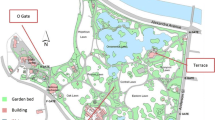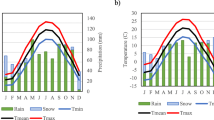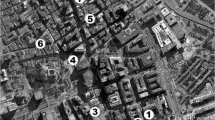Abstract
Tourists often use weather data as a factor for determining vacation timing and location. Accuracy and perceptions of weather information may impact these decisions. This study: (a) examines air temperature and dew points from seven exclusive resorts in the Phoenix metropolitan area and compares them with official National Weather Service data for the same period, and (b) utilizes a comfort model called OUTCOMES—OUTdoor COMfort Expert System—in a seasonal appraisal of two resorts, one mesic and one xeric, compared with the urban Sky Harbor International Airport first-order weather station site in the central urban area of Phoenix, Arizona, USA (lat. 33.43°N; long. 112.02°W; elevation at 335 m). Temperature and humidity recording devices were placed within or immediately adjacent to common-use areas of the resorts, the prime recreational sites used by guests on most resort properties. Recorded data were compared with that of the official weather information from the airport station, a station most accessible to potential tourists through media and Web sites, to assess predicted weather for vacation planning. For the most part, Sky Harbor’s recorded air temperatures and often dew points were higher than those recorded at the resorts. We extrapolate our findings to a year-round estimate of human outdoor comfort for weather-station sites typical of resort landscapes and the Sky Harbor location using the OUTCOMES model to refine ideas on timing of comfortable conditions at resorts on a diurnal and seasonal basis.





Similar content being viewed by others
References
Agnew MD, Palutikof JP (2001) Climate Impacts on the Demand for Tourism. In: Matzarakis A, de Freitas CR (eds) Proceedings of the First International Workshop on Climate, Tourism and Recreation. International Society of Biometeorology, Commission on Climate Tourism and Recreation, pp 44-50 (http://www.mif.uni-freiburg.de/isb/)
Baker LA, Brazel AJ, Selover N, Martin C, McIntyre N, Steiner FR, Nelson A, Musacchio L (2002) Urbanization and warming in Phoenix (Arizona, USA): Impacts, feedbacks and mitigation. Urban Ecosyst 6:183–206
Balling RC, Lolk NK (1991) A developing cool island in the desert? The case of Palm Springs, California. J Ariz-Nev Acad Sci 23(2):93–96
Braun OL, Lohmann M, Maksimovic O, Meyer M, Merkovic A, Messerschmidt E, Riedel A, Turner M (1999) Potential impact of climate change effects on preferences for tourism destinations: A psychological pilot study. Clim Res 11(3):247–254
Brazel, AJ (2003) Future Climate in Central Arizona: Heat and the Role of Urbanization. Arizona State University, Consortium for the Study of Rapidly Growing Regions, Research Vignette No. 2, September, 2003
Brazel AJ, Selover N, Vose R, Heisler G (2000) The tale of two climates-Baltimore and Phoenix urban LTER sites. Clim Res 15(2):123–135
Brazel AJ, Crewe K (2002) Preliminary test of a surface heat island model (SHIM) and implications for a desert urban environment, Phoenix, Arizona. J Ariz-Nev Acad Sci 34(2):98–105
Brown, RD, Gillespie TJ (1995) Microclimatic landscape design: Creating thermal comfort and energy efficiency. John Wiley, New York
Bruse, M (2000) Assessing thermal comfort in urban environments using an integrated dynamic microscale biometeorological model system. 3rd Symposium on the Urban Environment, Davis, CA, American Meteorological Society, pp 159–160
Christensen NS, Wood AW, Voisin, N, Lettenmaier DP, Palmer RN (2004) The effects of climate change on the hydrology and water resources of the Colorado River Basin. Clim Change 62:337–363
de Freitas, CR (2001) Theory, Concepts and Methods in Tourism Climate Research. In: Matzarakis A, de Freitas CR (eds) Proceedings of the First International Workshop on Climate, Tourism and Recreation. Porte Carras, Halkidiki, Greece, October 2001. International Society of Biometeorology, Commission on Climate Tourism and Recreation, pp 3–20. http://www.mif uni-freiburg.de/isb/
de Freitas CR (2002) Tourism Climatology; The Way Forward. Bulletin of the American Meteorological Society. December, 2002
de Freitas CR (2003) Tourism climatology: evaluating environmental information for decision making and business planning in the recreation and tourism sector. Int J Biometeorol 48(1):45–54
Fanger PO (1970) Thermal comfort; Analysis and applications in environmental engineering. McGraw-Hill Book Co, New York
Fernando, HJS, Lee SM, Anderson J, Princevac M, Pardyjak E, Grossman-Clarke S (2001) Urban fluid mechanics: air circulation and contaminant dispersion in cities. Environ Fluid Mech 1:107–164
Greater Phoenix Convention and Visitors Bureau (2003) http://www.phoenixcvb.com/ Accessed: January 24, 2003
Heisler GM, Wang Y (2002) Applications of a human thermal comfort model. In preprints of Fourth Symposium on the Urban Environment, 20–24 May 2002, Norfolk, VA (American Meteorological Society) pp 70–71 (available http://www.fs.fed.us/ne/syracuse/Pubs/Downloads/02_GH_YW_Applications.pdf)
Höppe P (1999) The Physiological Equivalent Temperature - a universal index for the biometeorological assessment of the thermal environment. Int J Biometeorol 43(2):71–75
Jendritzky G, Nubler W (1981) A model analyzing the urban thermal environment in physiologically significant terms. Archiv For Meteorol Geophys Bioclimat Ser B 29:313–326
Jenerette GD, Wu J (2001) Analysis and simulation of land-use change in central Arizona-Phoenix region, USA. Landsc Ecol 16:611–626
Matzarakis, A (1999) Required meteorological and climatological information for tourism. Proceedings of the 15th International Congress of Biometeorology & International Conference on Urban Climatology. (ed) de Dear RJ, Potter JC. ICBP08.01, pp 1–6
Matzarakis A, Mayer H, Iziomon, MG (1999) Applications of a universal thermal index: physiological equivalent temperature. Int J Biometeorol 43(2):76–84
Mueller EC, Day TA (2005) The effect of urban ground cover on microclimate, growth and leaf gas exchange of oleander in Phoenix, Arizona. Int J Biometeorol 49:244–255
National Oceanic and Atmospheric Administration (2003) NOAA-CIRES Climate Diagnostics Center. Available: http://www.cdc.noaa.gov/Composites/Day/ Accessed: June 25, 2003
National Renewable Energy laboratory (1995) User’s Manual for TMY2s Typical Meteorological Years. US Dept of Energy, 49 pp (and accompanying CD for data in the USA)
Perry AH (1997) Recreation and tourism. In: Perry, AH, Thompson, R (eds) Applied Climatology: Principles and Practice. Routledge, London, pp 240–248
Pickup J, de Dear R (1999) An outdoor thermal comfort index (OUT-SET*): Part I-The model and its assumptions. Proceedings of 15th International Congress of Biometeorology & International Conference on Urban Climatology, Macquarie University, Sydney, Australia pp 279–281
Schmidli RJ (1996) CLIMATE OF PHOENIX, ARIZONA: An Abridged On-Line Version of NOAA Technical Memorandum NWS WR-177. (http://www.geography.asu.edu/Cerveny/phxwx.htm)
Scott D, McBoyle G (2001) Using a ‘tourism climate index’ to examine the implications of climate change for climate as a natural resource for tourism. Proceedings of the First International Workshop on Climate, Tourism and Recreation. International Society of Biometeorology, Commission on Climate Tourism and Recreation, pp 69–98. (http://www.mif.uni-freiburg.de/isb)
Sprigg WA, Hinkley T (2000) Preparing for a Changing Climate-the Potential Consequences of Climate Variability and Change: Report of the Southwest Regional Assessment Group (Consortium of the Institute for the Study of Planet Earth of the university of Arizona, NOAA and Dept. of the Interior, USGS)
Stewart JQ, Whiteman CD, Steenburgh, WJ, Bian, X (2002) A climatological study of thermally driven wind systems of the U.S. Intermountain West. Bull Am Meteorol Soc 83(5):699–708
World Travel and Tourism Council. (2005) http://www.wttc.org Accessed: February 13, 2006
Wang Y, Heisler GM (2003). Outdoor Human Comfort Expert System (OUTCOMES) [cited October 8, 2003]. Available from http://www.fs.fed.us/ne/syracuse/Tools/tools.htm
Wang Y (2003) An Analysis of an Expert System Used to Predict Human Thermal Comfort in Outdoor Urban Settings, PhD Dissertation, State University of New York, College of Environmental Science and Forestry, Syracuse, NY
Acknowledgements
Although resort managers wish to remain anonymous, we wish to thank them very much for allowing the field collection phase of this study. We would like to thank cartographer Barbara Trapido-Lurie of ASU Geography Department for graphics.
Author information
Authors and Affiliations
Corresponding author
Rights and permissions
About this article
Cite this article
Hartz, D.A., Brazel, A.J. & Heisler, G.M. A case study in resort climatology of Phoenix, Arizona, USA. Int J Biometeorol 51, 73–83 (2006). https://doi.org/10.1007/s00484-006-0036-9
Received:
Revised:
Accepted:
Published:
Issue Date:
DOI: https://doi.org/10.1007/s00484-006-0036-9




